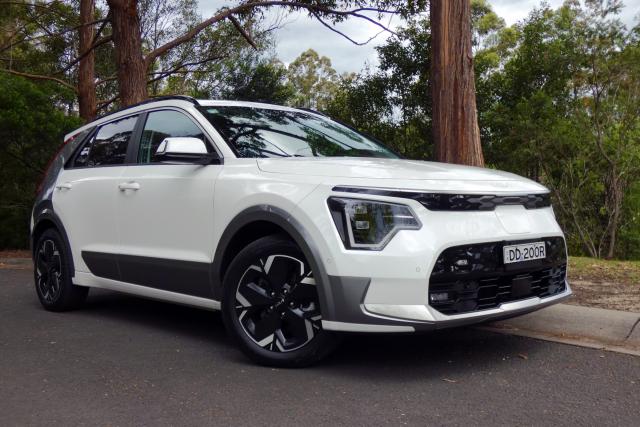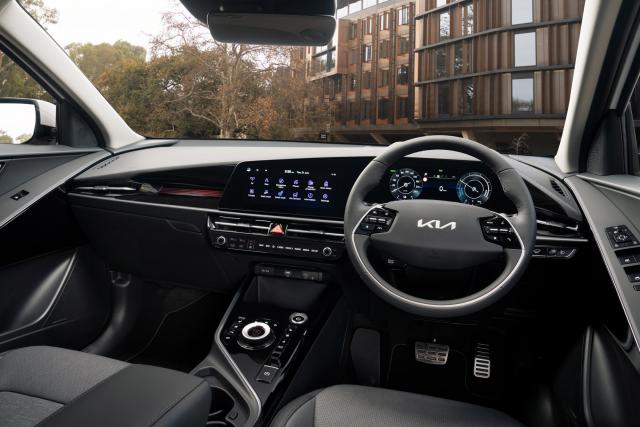Not before time, it’s a chance to dip a toe into the expanding pool of Kia electric vehicles with a stint in the Niro compact sports utility, albeit the top-of-the-range GT-Line.
And there looms the first obstacle: where the EV models open their account at $44,380, plus on-road costs, for the petrol / electric hybrid Niro HEV S, the full electric GT-Line sets back the buyer $72,100. That’s a big pile of dosh to step over.
And what do you receive in return?
The second-generation Niro has landed with a new look, new advanced technology, reworked powertrains, for the first time Kia Connect connected services, and what Kia claims is a 460-kilometre range.
Kia Connect is an intelligent remote-control app with functions including remote engine start, door lock control and remote climate control, as well as innovative in-car services such as destination and vehicle tracking and system status, valet parking mode, local points of interest and emergency call feature.
Kia Connect is covered over the full Kia seven-year unlimited kilometre warranty and is fully transferable.
The Niro EV has extended Kia’s vehicle bidirectional charging ability whereby the vehicle can not only receive power but supply it from its high-voltage battery. In this case the so-called vehicle-to-load (V2L) capability can be used to charge external devices such as laptops.
Damien Meredith, chief operating officer of Kia Australia, said the Niro represented a sizeable improvement over its predecessor, helping to bolster the Korean manufacturer’s local line-up of electrified vehicles.
STYLING
There is no mistaking the new-look Niro EV GT-Line with its striking colours. The test car, for example, was Snow White Pearl with contrasting Steel Grey panels on both sides between the C-Pillar and rear.
Underpinning this post-modern patterning were unique jazzy 17-inch alloy wheels.
Up front a compact LED light set-up combines headlamp, daytime running lights and turn indicators, while rear lights include an integrated aerodynamic design that cleans airflow to help improve illumination.
The styling is regular SUV stuff and in GT-Line is topped off with a panoramic sunroof and powered tailgate.
Charge points are not easy to find on some EVs. Not so here: access is via an instantly recognisable flap situated in the centre of where an ICE radiator would normally live.
INTERIOR
The new SUV platform translates to ample space inside the cabin, capable of taking up to five occupants in relative comfort. Faux leather trim extends to front heated and ventilated seats and two-spoke heated steering wheel.
Bigger than before, with every dimension but height increasing, seat and steering wheel adjustment are adequate for comfortable driving, while the rear bench is flat and can be firm on longer journeys. Leg and headroom are good.
The rotary transmission controller and push button motor start / stop switch share the centre console.
Boot space, accessed via a power tailgate, has taken a jump to 475 litres but with the seats down, 1392 litres is thirteen fewer than the old car.
An under-bonnet boot holds 20 litres and is home to the battery charging lead
in a dedicated compartment, while the V2L plug is located in the base of the rear seat at hand for running laptops or other small appliances.
INFOTAINMENT
Two 10.25-inch screens take pride of place in the GT-Line’s digital dash – to the left speedo and the right a power metre. The other media and entertainment screen is packed with features including an innovative display showing the power flow and the charge state of the battery.
There’s also a 10-inch colour head-up windscreen display, while an eight-speaker harman / kardon audio delivers quality DAB+ radio and also has USB Apple CarPlay and Android Auto. There’s a wireless phone charging point up front
POWERTRAIN
The Niro EV 150 kW electric motor is carried over from the existing car, Kia stating it now develops 255Nm – 140 Nm shy of the outgoing model without performance being compromised but range being improved. Drive is sent to the front wheels through a single reduction gear transmission, with the 64.8 kWh battery pack enabling a driving range of up to 460 kilometres, five kilometres more than the car it replaces.
SAFETY
ANCAP is yet to assess and crash-test the Niro so it does not yet have a rating. Eight airbags (dual front, dual side, dual curtain, driver’s knee and centre) feature across the Niro range.
Active safety includes anti-lock brakes, stability and traction control, forward collision warning, forward Autonomous emergency braking with junction collision avoidance, reverse AEB, blind spot monitoring, lane departure warning, lane keep assist, reversing camera, forward and reverse cross-traffic alert, exit and rear seat occupant warning.
DRIVING
First impressions are the quietness of the car – from engine and wind to road surface noise – the result of advanced sound deadening material.
One of three drive modes – Eco, Normal and Sport – can be called up by means of a steering wheel-mounted button. Eco is largely forgettable, Sport is firmer but less economical, while Normal is relaxed and in keeping with the car’s character.
With a factory claimed 16.3 kWh per 100-kilometre average fuel consumption, the test car recorded an accumulated figure of 14.1 kWh per 100 kilometres average over a week of mixed driving.
A top-up battery charge of around 20 per cent, to 80 pc on a public fast charger, took 40 minutes, pushing the car’s range to 300-plus kilometres. Cost was less than $6.
Kia conducted a full ride and handling tune for the second-generation Niro in Australia, making it the first vehicle from the Korean brand to receive steering map changes since the onset of the COVID-19 pandemic in 2020.
Steering wheel paddles can be used to choose between three levels of braking regeneration. The strongest is good in traffic and delivers a pretty good one-pedal driving experience.
The turning circle is a solid 10.6 metres and thoughtfully Kia has kicked in with a remote parking feature where the key fob can be used to start the car and roll it forward and back to fit in tight garages or shopping centre spots.
SUMMARY
The Kia Niro EV GT-Line is fine on fuel economy, comfort, range and charging convenience. However, $70K-plus is a lot to step over before getting into the car.









